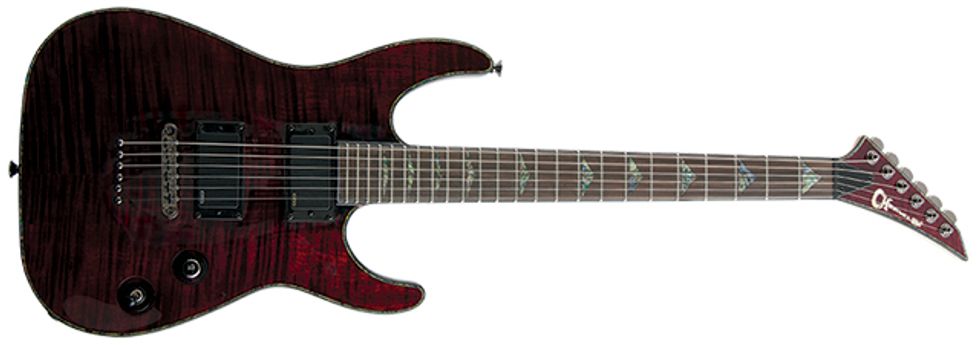Since the ’80s, the name Charvel has been more or less synonymous with hot-rodded solidbodies. With strong Fender roots, Charvel adopted a no-frills approach to guitar design that helped usher in an era of streamlined shred machines for players seeking the perfect platform for acrobatic lead work, raunchy rhythms, and supreme tuning stability for tremolo dive-bombing.
Fast-forward to 2013, and Charvel—now operating under the umbrella of the Fender family—is still building guitars that expertly blend proven designs with stripped-down, shred-oriented elements. The Desolation Soloist DX-1 ST blends classic “super strat” concepts that metal players have grown to love with a silky, slender neck, a deeply carved neck joint, and mammoth-sized tone.
A Meeting of the Minds
The Chinese-made Desolation DX-1 ST combines the sleek look of the famed Soloist model from Jackson (another company that’s now in the Fender family) with flashy aesthetic accents. The curvy mahogany body sports a string-though design, multi-ply binding, a vibrant flamed-maple top (with transparent finish only), a black-nickel Tune-o-matic-style bridge, and a scalloped heel for easy access to the three-piece, through-body maple neck's higher registers. The unfinished neck's oiled wood treatment makes it extremely comfortable, smooth, and friction free when you’re reaching for any of its 24 jumbo frets. A set of black-nickel locking tuners keeps the strings firmly in tune, even after pulling seriously big bends. Add the matching, flamed-maple headstock veneer and striking abalone fretboard inlays, and the Desolation DX-1 ST is pretty eye-catching on top of being a wonderfully comfortable guitar to play.
The Desolation is powered by a pair of EMG 81 and 85 active pickups—long a popular combination with metal guitarists who like their searing highs, immediate response, and drum-tight bottom end. Output is managed by a 3-way switch and a single volume control, a fact that will be a bit of a disappointment to players who love the creamy, even tone of an overdriven 85 with the tone rolled all of the way off. It's understandable that Charvel would want to keep things simple—and, admittedly, a tone control probably doesn’t rank high on a lot of heavy shredders’ list of needs—but its absence limits the guitar’s tonal versatility to just about everyone else.
Apart from a few minor adjustments, the Desolation was ready to play right out of the case. The action was a tad low when tuned to standard pitch, but not so wildly off the mark that it took more than a minute or two to properly set the bridge to a buzz-free height. The guitar’s smooth carves made it feel like the mahogany body was locked to mine—something I found really helpful during more acrobatic fretboard-climbing moments.
Kickstart My Heart
As streamlined as the Desolation’s controls may be, it still generates a wealth of fierce metal and hard-rock tones. But it just as ably handles lower-gain situations. Using a Mesa/Boogie Dual Rectifier to churn through a cache of old-school thrash riffs, I found that the EMG 81 bridge pickup delivered super-hot high end and a very focused low end that remained clear no matter how much gain I stacked on top. The guitar’s mahogany body seemed to add a slightly rubbery response to the midrange, but you can also hear some snappy highs and lows that may well be the product of the maple top. Whatever it was due to, it helped lend definition to rumbling drop-tuned chords and legato leads. Decreasing the Boogie’s gain to around halfway enabled the guitar’s midrange to speak more clearly and generate more of a velvety classic-rock crunch. For the most part, the balance between the low-end girth and top-end shimmer is very good, but if you tend to operate your amp in trebly high-gain zones, the high end can become somewhat rigid and bristly, underscoring the DX-1 ST’s lack of a tone control.
Ratings
Pros: Fantastic build quality. Superbly comfortable neck profile. Handles roaring metal rhythms with aplomb.
Cons: Clean tones can sound anemic. Lack of tone control makes it difficult to tame excessive highs.
Tones:
Playability:
Build/Design:
Value:
Street: $649
charvel.com
The neck-position EMG 85 was much more responsive for coaxing smooth cleans and lightly overdriven tones, thanks to its supremely deep lows and glassy high end. The pickup’s natural midrange scoop was a little too intense for warmer-sounding blues and jazz progressions, but it helped lows and highs bloom when playing arpeggios. And with a touch of overdrive from the Mesa’s orange channel, the Charvel was quite capable of generating midrange punch for gritty lead work and growling rhythms. Pushing the gain up even further loosened the lows slightly and focused the highs and attack, transforming the Charvel into a perfect canvas for clear legato and sweep-picking work. Unfortunately, the attack was so focused on notes higher up the fretboard that they became piercing if I picked too hard. Adjusting the amp’s presence helped make the attack less strident, but the tone also lost a noticeable amount of body in the upper mids. Again, this is something a tone control would’ve helped remedy.
The Verdict
A metal maniac who needs a solid guitar that’s both easy on the eyes and
the wallet will find it hard to turn away from the Charvel Desolation
DX-1 ST. The build quality is exceptional, the tones can range from
mellow to very aggressive, and the neck is to die for. Its clean tones
won’t overshadow your favorite Stratocaster or Telecaster—and the lack
of a tone knob makes it almost impossible to tame the strong treble in
some situations. Yet, when considering the guitar’s incredible
playability and crushing overdriven tones, those quibbles can feel like
small trade-offs, especially at such a great price.








![Rig Rundown: Russian Circles’ Mike Sullivan [2025]](https://www.premierguitar.com/media-library/youtube.jpg?id=62303631&width=1245&height=700&quality=70&coordinates=0%2C0%2C0%2C0)

















